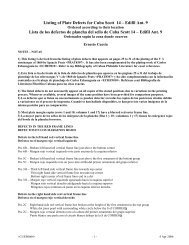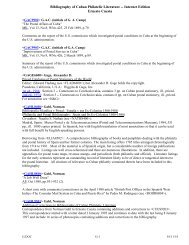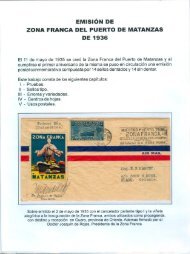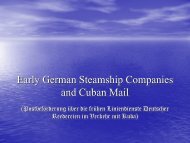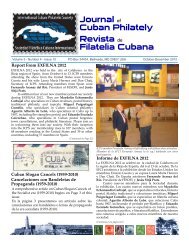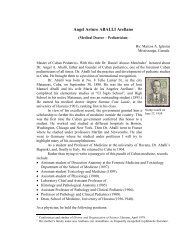The Cuban Philatelist - Ernesto Cuesta
The Cuban Philatelist - Ernesto Cuesta
The Cuban Philatelist - Ernesto Cuesta
You also want an ePaper? Increase the reach of your titles
YUMPU automatically turns print PDFs into web optimized ePapers that Google loves.
organizar el Departmento de Antropología, que más tarde pasó a<br />
ser la Sociedad <strong>Cuban</strong>a de Antropología.<br />
Tras la invasión americana, en diciembre de 1899 el<br />
Gobernador General de la División <strong>Cuban</strong>a y Brigadier General<br />
Adna R. Chaffer nombró a Montané para dirigir el Departmento<br />
de Antropología de la Universidad de La Habana. El 29 de junio<br />
de 1903 el rector de la Universidad de La Habana bautizó a la<br />
colección del Departmento de Antropología como el Museo<br />
Antropológico Montané. El Museo Montané está en el segundo<br />
piso del Edificio Felipe Poey en la Universidad de La Habana,<br />
donde se exhibe un gran número de artefactos encontrados por<br />
toda la isla. Montané enseñó en La Universidad de La Habana<br />
hasta su retiro en 1920, partiendo a Francia donde falleció en<br />
1936.<br />
Los tres sellos muestran importantes artefactos taínos<br />
que son parte de la colección Montané. El sello de dos centavos<br />
(Scott 791) muestra una figurita taína conocida como el Ídolo de<br />
Tabaco, que fue encontrada en 1906 en una cueva en la región de<br />
Maisí en la punta este de Cuba. El artefacto de madera es una<br />
representación de un hombre, de cerca de un metro de altura,<br />
tallado en una madera tropical llamada guayacán con conchas<br />
incrustadas. La figura tiene un hueco bastane grande donde se<br />
piensa que se ponían los huesos de un antepasado en forma de<br />
reverencia.<br />
El sello de tres centavos (Scott 792) muestra un asiento<br />
ceremonial conocido como el Dujo de Santa Fe. Por las crónicas<br />
españolas se sabe que los dujos se usaban como una especie de<br />
tronos por los caciques durante rituales. Según el cronista español<br />
Gonzalo Fernández de Oviedo, los jefes taínos se enterraban<br />
sentados en sus duhos. El Dujo de Santa Fe fue descubierto<br />
enterrado en la ribera del Río Santa Ana en las afueras de La<br />
Habana.<br />
El sello de nueve centavos (Scott 793) muestra un<br />
artefacto conocido como el Ídolo de Bayamo. Esta figurita está<br />
tallada en piedra arenosa oscura, y mide cerca de un pié. Fué<br />
descubierta en 1848 enterrada en el rancho Valenzuela en<br />
Bayamo, en la parte este de Cuba, y fue donada a la Universidad<br />
de La Habana por el destacado estudioso Miguel Rodríguez<br />
Ferrer. El Ídolo de Bayamo era probablemente un cemí, una<br />
figura ceremonial taína que representaba sus dioses y espíritus<br />
ancestrales. El cronista español Padre Ramon Pané describe la<br />
adoración de los cemíes de piedra por los taínos con ceremonias y<br />
los frutos de las primeras cosechas.<br />
Para marcar el 30º aniversario de la Sociedad<br />
Espeleológica <strong>Cuban</strong>a, se emitió una serie de siete sellos (Scott<br />
1507-1513) el 28 de marzo de 1970, reproduciendo pinturas<br />
rupestres de los siboneyes y taínos. Usando las ilustraciones de<br />
Raimundo García Parra, los sellos fueron impresos por la Planta<br />
Impresora de Especies Postales William Soler, el impresor del<br />
MINCOM en La Habana, en offset a todo color. La espeleología<br />
es la ciencia física que se dedica a la exploración de las cuevas<br />
naturales, tanto como deporte como investigación científica. Los<br />
espeleólogos en Cuba han encontrado muchas pinturas rupestres<br />
durante sus exploraciones, creando lazos con la arqueología y la<br />
antropología, usualmente consideradas como ciencias sociales.<br />
After the American invasion, in December 1899,<br />
Governor General of the <strong>Cuban</strong> Division and Brigadier<br />
General Adna R. Chaffer named Montane to chair the<br />
Anthropology Department at the University of Havana. On<br />
29 June 1903 the rector of the University of Havana<br />
denominated the working collection of the Anthropology<br />
Department as the Montane Anthropological Museum. <strong>The</strong><br />
Montane Museum is located on the second floor of the Felipe<br />
Poey Building at the University of Havana, where a number<br />
of artifacts from sites all over the island are displayed.<br />
Montane taught at the University of Havana until 1920 when<br />
he retired, leaving for France where he passed away in 1936.<br />
<strong>The</strong> three stamps show important Taino artifacts that<br />
are part of the Montane collection. <strong>The</strong> two centavos stamp<br />
(Scott 791) shows a Taino figurine known as the Idolo de<br />
Tabaco, which was recovered in 1906 from a cave in the<br />
Maisi region in easternmost Cuba. <strong>The</strong> wooden artifact is the<br />
representation of a male human, about three feet tall, carved<br />
from a tropical hardwood known as guayacan with shell<br />
inlays. <strong>The</strong> figure contains a substantial hollow space that is<br />
thought to have held the bones and remains of a revered<br />
ancestor.<br />
<strong>The</strong> three centavos stamp (Scott 792) shows a<br />
ceremonial sitting stool known as the Dujo de Santa Fe.<br />
Dujos are known from the Spanish chronicles that describe<br />
their use as thrones by chieftains during rituals. According to<br />
Spanish chronicler Gonzalo Fernandez de Oviedo, Taino<br />
chiefs were buried seated on their dujos. <strong>The</strong> Dujo de Santa<br />
Fe was discovered buried along the banks of the Santa Ana<br />
River on the outskirts of Havana.<br />
<strong>The</strong> nine centavos stamp (Scott 793) shows the<br />
artifact known as the Idolo de Bayamo. <strong>The</strong> figurine is<br />
carved from dark color sandstone, measuring about one foot<br />
tall. It was discovered in 1848 buried on the Valenzuela ranch<br />
in Bayamo in eastern Cuba and was donated to the University<br />
of Havana by noted scholar Miguel Rodriguez Ferrer. <strong>The</strong><br />
Idolo de Bayamo most likely was a cemí, a Taino ceremonial<br />
carved figurine that imaged the Taino gods and ancestral<br />
spirits. Spanish chronicler Father Ramon Pane described the<br />
Taino worship of stone cemi idols with ceremonies and the<br />
fruits of first harvests.<br />
To mark the 30th anniversary of the <strong>Cuban</strong><br />
Speleological Society, a set of seven stamps (Scott 1507-<br />
1513) were issued on 28 March 1970, showcasing Siboney<br />
and Taino cave drawings. Using illustrations by Raimundo<br />
Garcia Parra, the stamps were printed by the Planta<br />
Impresora de Especies Postales William Soler, the MINCOM<br />
in-house printer in Havana, using full color offset.<br />
Speleology is the physical science pursuit of exploring<br />
natural caves, either as a sport or as scientific research.<br />
Spelunkers in Cuba have found many cave drawings in the<br />
course of their explorations, creating unique links with<br />
archaeology and anthropology, usually considered social<br />
sciences. Many ancient cultures including the Siboney and<br />
Taino treated caves as sacred spaces, which they were<br />
decorated with sacred drawings and images. <strong>The</strong> narrative of<br />
77 <strong>The</strong> <strong>Cuban</strong> <strong>Philatelist</strong>. Last Half 2005.



